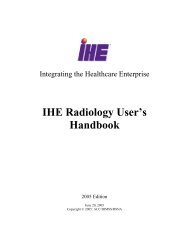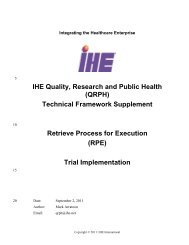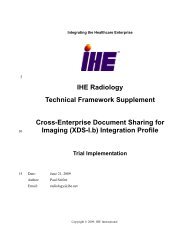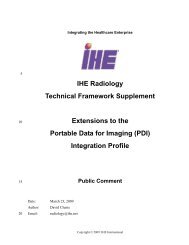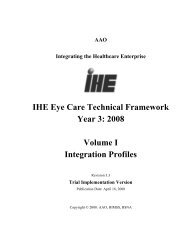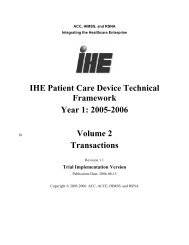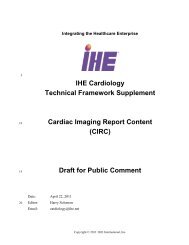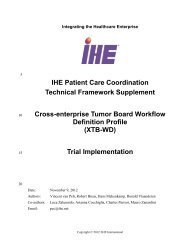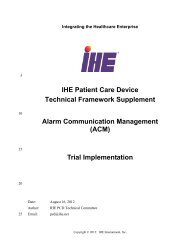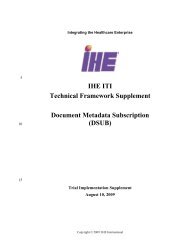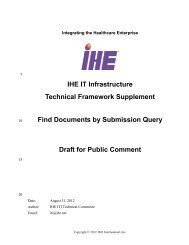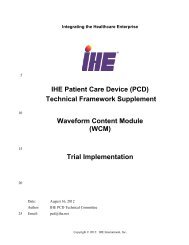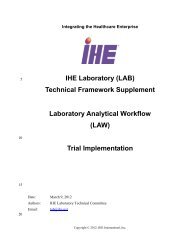XDW - IHE
XDW - IHE
XDW - IHE
Create successful ePaper yourself
Turn your PDF publications into a flip-book with our unique Google optimized e-Paper software.
<strong>IHE</strong> IT Infrastructure Technical Framework Supplement – Cross-Enterprise Document<br />
Workflow (<strong>XDW</strong>)<br />
______________________________________________________________________________<br />
425<br />
430<br />
435<br />
440<br />
Likewise, the clinical and administrative documents that are used as input and produced<br />
as output by the tasks of workflows managed by the <strong>XDW</strong> profile are shared using the<br />
same first layer of this architecture.<br />
• The third layer introduces the semantic definition of the workflows that can be<br />
understood and executed among the participating systems/applications. The orchestration<br />
of specific workflows allows the workflow participants to share a common understanding<br />
of the specific tasks, the dependencies between these tasks, and a number of rules that<br />
control the workflow execution.Execution details are conveyed through the <strong>XDW</strong><br />
Workflow Document defined by the second layer of the architecture. The specification<br />
of Workflow Definitions at this third layer is distinct from the <strong>XDW</strong> Profile and is<br />
currently best handled with a natural language expression (See example of Basic<br />
Unstructured Workflow Definition Profile, ITI TF-3:Appendix X).<br />
• The fourth layer of this architecture contains the applications executed by the<br />
participating systems. Such applications bridge between <strong>XDW</strong> managed workflow and<br />
the locally managed workflow. Much of the details of the local workflows managed by<br />
each application will be hidden and encapsulated in “higher” granularity tasks exposed<br />
through <strong>XDW</strong>, as such details would not need to be externally exposed. The workflow<br />
definitions conveyed by the third layer should only contain higher granularity tasks that<br />
require workflow coordination across organizational boundaries.<br />
445<br />
450<br />
455<br />
X.4.1.2 <strong>XDW</strong> Document Structure<br />
The <strong>XDW</strong> Profile uses the <strong>XDW</strong> Workflow Document to manage workflows.<br />
The <strong>XDW</strong> Workflow Document enables participants in a multi-organization environment to<br />
manage and track the execution of patient-centric workflows. The structure of<br />
WorkflowDocument is organized into Tasks and TaskEvents.<br />
A Task describes an activity, or a group of activities, that need to be accomplished or have been<br />
accomplished. A Task is characterized by several attributes:<br />
• the type of task,<br />
• the owner of the task,<br />
• the current status that are valid for this task,<br />
• the references to documents used for input or produced as output<br />
• the history of past Task Events for this task, that document the progress of the task up to<br />
the present state<br />
When a person or organization has been assigned as owner of the task, the task is placed under<br />
execution. (It moves from a “created” or “ready” state to an “in-progress” state). When the<br />
expected activity(ies) is completed successfully the task moves to the completed state, otherwise<br />
to the failed state (for the state diagram see ITI TF 3: 5.X.4.2.4).<br />
___________________________________________________________________________<br />
15<br />
Rev. 2.0 – 2011-07-29<br />
Copyright © 2011: <strong>IHE</strong> International, Inc.



